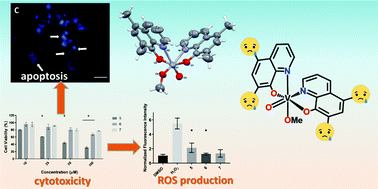In vitro antiproliferative effect of vanadium complexes bearing 8-hydroxyquinoline-based ligands – the substituent effect†
Abstract
This is the first comprehensive study demonstrating the antiproliferative effect of vanadium complexes bearing 8-hydroxyquinoline (quinH) ligands, including the parent and –CH3 (Me), –NO2, –Cl and –I substituted ligands, on HCT116 and A2780 cancer cell lines. To determine the structure–cytotoxicity relationships seven six-coordinate oxovanadium(V) complexes [VO(OMe)(5,7-(Me)2-quin)2] (1), [VO(OMe)(5,7-Cl2-quin)2] (2), [VO(OMe)(5,7-Cl,I-quin)2] (3), [VO(OMe)(5,7-I2-quin)2] (4), [VO(OMe)(5-NO2-quin)2] (5), [VO(OMe)(5-Cl-quin)2] (6), and [VO(OMe)(quin)2] (7) were investigated. The cytotoxicity of 8-hydroxyquinoline oxovanadium(V) complexes is higher in the A2780 cell line (lower IC50) than that observed for the widely used chemotherapeutic agent, cisplatin, while displaying low cytotoxicity for normal human primary fibroblasts. Substituents introduced into the 8-hydroxyquinoline backbone reduced the antiproliferative effect of the vanadium complexes, and the complexes with the ligand substituted only in the 5 position (5 and 6) were more cytotoxic than those with substituents in the 5,7 positions of the quin backbone (1–4). Depending on the substituent type, the cytotoxicity of 1–4 followed the trend: –Cl > –CH3 > –I. Incubation of A2780 cancer cells with IC50 concentrations of complexes 5, 6 and 7 promoted cellular detachment, possibly through membrane destabilization, and triggered apoptosis and necrosis. ROS production might be responsible for the cell death mechanism observed particularly in the A2780 cells exposed to complexes 5 and 6.



 Please wait while we load your content...
Please wait while we load your content...